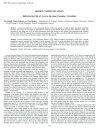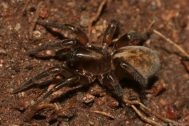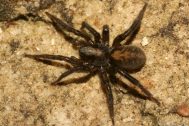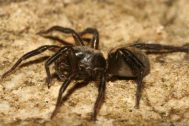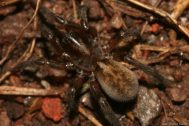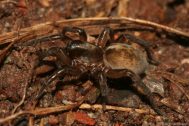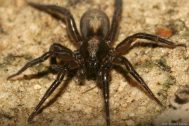| Nálezy podle období | |||||
|---|---|---|---|---|---|
| Lycosidae | 0-1900 | 1901-1950 | 1951-2000 | 2001+ | ∑ |
| Arctosa lutetiana (Simon, 1876) Ohrožený | 1× | 113× | 62× | 176× | |
Arctosa lutetiana (Simon, 1876)
| České jméno | slíďák lesostepní |
|---|---|
| Stupeň ohrožení | Ohrožený |
| Nálezy | 176 nálezů, 33 kvadrátů |
| První nález |
1894, A. Nosek, Nosek 1895 |
| Poslední nález | 2024 , František Houška |
| Areál rozšíření | European - eM (U |
| Fytogeografická oblast |
|
| Původnost stanovišť |
|
| Vlhkost stanovišť |
|
| Stratum |
|
| Osvětlení stanovišť |
|
| Hojnost výskytu |
|
| Nadm. výška | 200-900 |
Literatura
Pavouci (Araneae) a střevlíkovití brouci (Coleoptera, Carabidae) vybraných vřesovišť v západních Čechách.
Results of the exploration of the araneofauna and the entomofauna in West Bohemian heathlands are presented. Spiders and carabid beetles were collected during the vegetation seasons in 2011 and 2012 by the method of pitfall trapping. In total, 3188 specimens of 171 Araneae species and 2168 specimens of 93 Carabid species were determined. The most frequent spiders were Xerolycosa nemoralis (Westring, 1861), a common forest species. The following identified species are listed among the endangered spiders in the Czech Republic in the category „endangered“: Alopecosa schmidti (Hahn, 1835), Micaria dives (Lucas, 1846), Peponocranium orbiculatum (O. P.-Cambridge, 1882), in the category „vulnerable“: Centromerus incilium (L. Koch, 1881), Evansia merens O. P.-Cambridge, 1900, Metopobactrus prominulus (O. P.-Cambridge, 1872), Arctosa figurata (Simon, 1876), Arctosa lutetiana (Simon, 1876), Pardosa nigriceps (Thorell, 1872), Gnaphosa bicolor (Hahn, 1833), Xysticus striatipes L. Koch, 1870, Evarcha laetabunda (C. L. Koch, 1846) and Trichopterna cito (Blackwall, 1841). The most remarkable species of the Carabids were the Amara equestris equestris (Duftschmid, 1812), Amara pulpani Kult, 1949, Bradycellus ruficollis (Stephens, 1828), Carabus arcensis arcensis Herbst, 1784, Carabus problematicus harcyniae Sturm, 1815, Cymindis axillaris axillaris (Fabricius, 1794), Cymindis vaporariorum (Linné, 1758), Masoreus wetterhallii wetterhallii (Gyllenhal, 1813), Olisthopus rotundatus rotundatus (Paykull, 1790). Studied material was reposited at the Department of Zoology of the West Bohemian Museum in Pilsen.
Epigeic Spiders from Lowland Oak Woodlands in the South Moravia Region (Czech Republic).
This paper presents spider faunistics from abandoned coppice oak forest stands located along the South Moravia region. Spiders were collected from May to July 2012 by pitfall trapping at eight different localities. We collected 1945 adult spiders representing 20 families, 53 genera, and 90 species. More than one-third of all the species are known to be xerothermophilous with ecological restrictions to open and partly shaded habitats such as forest-steppe and sparse forests which belong to endangered habitats along central Europe. The most abundant species were Pardosa alacris, Pardosa lugubris and Arctosa lutetiana from the family Lycosidae. In the surveyed area, 24 species were found listed in the Red List of Threatened Species in the Czech Republic (CR – 1 species, EN – 2 species, VU – 15 species, LC – 6 species). In general, we discovered a substantially diversified spider community with a large presence of rare and endangered species characteristic for open and xeric habitats.
Fotografie
Statistiky
Dle měsíce v roce
Dle nadmořské výšky
Dle metody sběru (176 použitých nálezů)
| Arctosa lutetiana (Simon, 1876) VU | Samci | Samice | Mláďata | Nálezy |
|---|---|---|---|---|
| Zemní past | 433 | 130 | 6 | 106 |
| Individuální sběr | 36 | 14 | 8 | 19 |
| Neurčeno | 49 | 8 | 2 | 42 |
| Sklepávání | 12 | 1 | 0 | 1 |
| Smyk | 0 | 1 | 1 | 2 |
| Prosev | 13 | 5 | 0 | 6 |
| Samci | Samice | Mláďata | Nálezy |
Dle biotopu (176 použitých nálezů)
| Arctosa lutetiana (Simon, 1876) VU | Samci | Samice | Mláďata | Nálezy |
|---|---|---|---|---|
| Kamenolomy | 32 | 3 | 0 | 7 |
| Suché křoviny | 85 | 51 | 0 | 8 |
| Suché louky | 9 | 3 | 0 | 7 |
| Lesy | 0 | 0 | 0 | 1 |
| Louky | 32 | 8 | 0 | 9 |
| Dubohabřiny | 1 | 0 | 0 | 3 |
| Suché doubravy | 20 | 12 | 0 | 6 |
| Pastviny | 0 | 0 | 2 | 1 |
| Neurčeno | 25 | 9 | 1 | 53 |
| Horské bučiny | 8 | 0 | 0 | 2 |
| Xerotermní travinobylinná společenstva | 32 | 6 | 1 | 9 |
| Rašeliniště | 0 | 1 | 0 | 1 |
| Reliktní bory na skalách | 1 | 0 | 0 | 1 |
| Lesní okraje | 4 | 1 | 0 | 4 |
| Lesostepní doubravy | 185 | 34 | 10 | 39 |
| Kamenité suti nižších poloh | 14 | 6 | 0 | 4 |
| Přirozené lesy | 0 | 1 | 0 | 1 |
| Skalní stepi na vápenci | 58 | 18 | 3 | 13 |
| Výsadby jehličnanů | 37 | 6 | 0 | 7 |
| Samci | Samice | Mláďata | Nálezy |




